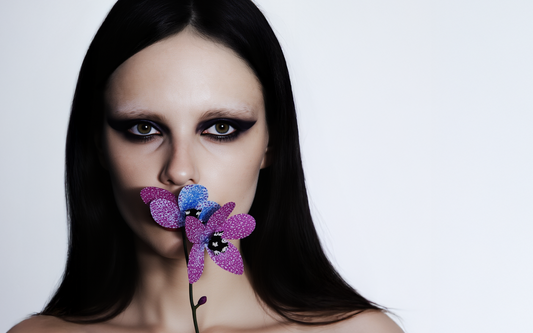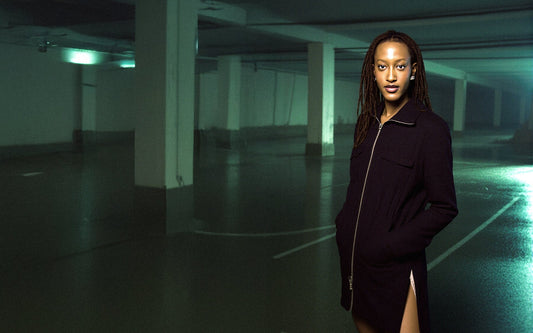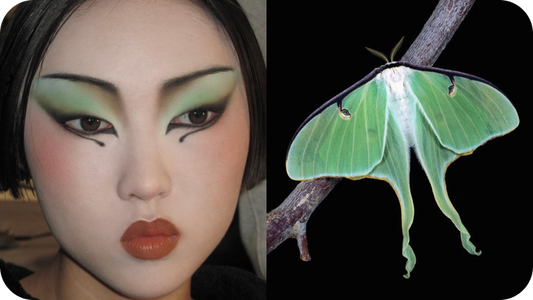IN A CENTRALIZED TECH LANDSCAPE, HOW DO ARTISTS COPE WITH THE LOSS OF KEY CREATIVE TOOLS? HOW DOES THE DISAPPEARANCE OF A PLATFORM IMPACT DIGITAL IDENTITIES AND LIVELIHOODS OF THE CREATORS USING THEM?
When Meta announced it would discontinue its AR filter creation software Spark AR along with UGC filters across it’s platform an entire genre of digital self-expression was suddenly compromised. RIP Insta Filters.
Shocking as it was, this "death" of a software is an inevitable reality for artists working in emerging technology, where platforms rise, evolve, and vanish, often with little warning.
We partnered with Zaiba Jabbar a curator and the founder of HERVISIONS, a femme-focused curatorial agency, to bring you an interview series featuring three multidisciplinary artists and creative technologists - Dr. Alex Box, Olivia Ema and Tabitha Swanson. Each working at the intersection of technology and beauty and pioneering new forms of self expression.
THE FIRST SPARK
‘Filters have expanded our perspective on creativity and creative expression and allowed the creator to decide what that could look like and how far they can push their expression of beauty.Not because digital is better but because it actually may not be physically possible. We can exist everywhere all at once in different ways.' - Olivia Ema

DIGITAL BEAUTY/ DIGITAL SELF
UGC tools for AR filters is an opportunity to reverse the typical top down nature of beauty norms. Creators we’re able to repossess or reclaim our digital self and reestablish agency over the beauty narrative in digital spaces, which we see more and more seeping into physical beauty too.

'There are many ways that I see this evolving, and being a part of how to equip people with the tools to maintain authorship in the digital beauty landscape. Firstly you have to establish what is 'self' and at what point you lost the claim to agency, did you ever have it and was it ever there!
I would argue the internet was founded on unregulated data, and that agency and ownership is what we are hopefully working towards.' - Dr. Alex Box
 Image: Olivia Ema
Image: Olivia Ema'Beauty and aesthetics have a major effect on the way we see ourselves and the worlds we inhabit…. I am so here for use repossessing our ideals around beauty, for far too long larger organisations and media outlets have dictated and defined what we should be seeing as beautiful…we’re becoming better at recognising a lens of beauty that doesn't amplify insecurity.
The me of Linkedin and the me of Tiktok are not the same, we have collectively agreed on embracing multiplicity, and we can express ourselves accordingly…we’re being invited to reimagine the self, it transcends our traditional understanding of self, we’re able to see ourselves ' - Olivia Ema
THE DEATH OF A SOFTWARE
When Meta announced they would be discontinuing the Spark platform there was a collective outcry from the community. Creative technologists are no stranger to platforms shutting down but the experience is still jarring and frustrating with all the time and effort invested. As of Jan, 2025 AR filters from community and brands will no longer be available on the platform.
‘When Spark AR announced its ending I was amongst a flurry of Spark AR creators shocked, with strong opinions, generally saddened. This is the first time i’ve experienced the discontinuing of a software and although I was loosely distancing from AR for a time to focus on my other practises, it stopped me in my tracks, it did feel a bit like a death and I had questions, one of the first things I done was go to Spark AR’s facebook page to check on the community and see how others were responding to the news. I think one of the hardest things to reckon with in all of this is the time invested. - Olivia Ema

Image: Olivia Ema
‘Augmented reality in beauty has been a performative prescriptive layer with no intuitive tools that translate real world skills. Platforms like spark were really great for digitally native creators but were a steep learning curve with a high barrier to entry for many, much like most software. Having intuitive tools is the first step to giving creators who have never been able to translate their real world skills a seat at the table.’ - Dr. Alex Box

Image: Dr. Alex Box
‘The identities we create online, and often put our hearts, souls, and energy into can be censored, banned, or deleted in an instant if the bot flags it. While it’s different, if someone is “deleted” in real life, there are legal actions that can be taken that are written into the law, but these platforms face no legal recourse and there is very little we can do when we’re deleted on there.
The work created with Spark AR is different than, for example, a video created and rendered with Blender. That video could still be experienced in its entirety if Blender shut down. But the filters created with Spark AR cannot be directly uploaded to another AR software and experienced, which makes this particular type of platform shut-down different.
It’s important to see things as they are and not as we want them to be. In Buddhism, there are said to be “Three Poisons” that are the source of suffering and hinder enlightenment: attachment, aversion, and ignorance. While it’s disappointing the filters I made will no longer be live and sharable, I’m thankful for all the opportunities I had during this era.‘ - Tabitha Swanson

Image: Tabitha Swanson
LOOKING AHEAD
These shifts in the industry create space for creators to reflect and question how to meaningfully contribute to the space through their practice. Looking ahead we see artists are still optimistic, adapting, pivoting to new tools and even building their own. As for UGC AR Filters Lens Studio, TikTok Effects House and Unity still offer robust tooling for a creator driven digital beauty. Plus with wearables with Spatial Computing built the space will continue to grow.
'death of any kind can offer a new beginning, but we first have to get through the shock and disarray. It's easy to believe all has been lost, I don't believe this is true, what we are losing is the familiarity of a platform, but our creativity and our ability to learn and innovate is ours and nobody or platform can take that away from us…as creatives we find creative ways to exist and adapt all the time, I think its in our DNA.’ - Olivia Ema

Image: Olivia Ema
'I’ve posited for a long time that filters were a natural first step to easily accessible AR…eventually, AR will be integrated with AI in very useful ways that allow us to do things like fix the plumbing in our homes by analyzing the situation and creating detailed customized guidelines on which parts to replace or readjust. I’m questioning my place as a digital visual artist, and working with AR is included in that…I’m about to pivot my life overall. I’ll always be an artist and make art, but I was accepted into Columbia University for next fall, where I’ll study international policy and focus on AI/tech policy. We’re in a crucial moment and the policies we make now will affect people for generations to come.' - Tabitha Swanon

Image: Tabitha Swanson
Dr. Alex Box recently launched V-METICS which presents an exciting evolution for the digital beauty space. Using UNREAL’s hyper realistic game engine.
At V-METICS we are creating these tools that allows anyone to apply real-world cosmetics to a digital human avatar in a 3D environment. It accurately simulates the real physics of materials and light applied to the skin. Seamlessly bridging the physical and digital worlds, this technology gives anyone the ability to create intuitively by accurately mirroring the process of application through movement, texture and colour. V-METICS also enables people to experiment, create and share their looks with real products freely from anywhere. - Dr. Alex Box

Image: Dr. Alex Box
ABOUT THE ARTISTS
ZAIBA JABBAR
Zaiba Jabbar is a moving image artist, award-winning director, curator, and founder of HERVISIONS, a femme-focused curatorial agency, platform and digital art studio that produces innovative commissions, exhibitions, and events with a strong focus on the intersection of art, technology, and culture.
With over fifteen years of experience in the film and media sectors, her curatorial practice with HERVISIONS investigates how marginalised people use technology to create art outside traditional contexts and make space for themselves in the digital environment. Jabbar was a curator in residence at LUX, London in 2018, is a board member of Abandon Normal Devices, and is currently an associate lecturer on the MA Computational Art course at Camberwell College. She is a leader in augmented reality and digital art exhibitions both online and offline.
DR. ALEX BOX
Dr. Alex Box is a visionary artist and pioneer of Beauty Futurism, redefining creativity in make-up, beauty, and identity. Formerly the Creative Director of the cult beauty brand Illamasqua, she is now the CEO of V-METICS, the first intuitive virtual cosmetics brand and tool, transforming the beauty landscape through AR, Web3, Game Engines and immersive technologies.
A pioneer of connective language, Dr. Box explores the themes of self and communication through material, tools, nature, and technology. Her practice spans philosophy, anthropology, and art, investigating systems and patterns to ask profound questions about what we need to feel more connected to emotion, play, humanity, and each other.
OLIVIA EMA
Olivia Ema is a digital artist and creative technologist working with AR, gaming engines, generative art, and digital humans to craft immersive experiences that explore new creative expressions of digital identity. Her heart-conscious approach to creative technology fosters dialogue on identity and reimagines tech with caring perspectives.
Olivia served as a judge and president for D&AD, examining immersive work and the potential of AR as a tool for meaningful connection. As a Black woman in creative tech, she challenges norms by creating inclusive worlds where people can see themselves represented and connected.
TABITHA SWANSON
Tabitha Swanson is a Berlin-based multidisciplinary artist, designer, and creative technologist whose work spans 3D, animation, augmented reality, AI, digital fashion, graphic design, and UX/UI. Her practice is guided by curiosity and a deep interest in exploring systems—whether technological, cultural, or spiritual—using art as a medium for introspection and connection.
Recently, she was accepted to Columbia University to study international policy, with a focus on AI and technology governance. Subscribe to her substack SEEK/FIND.
 Log in
Log in



